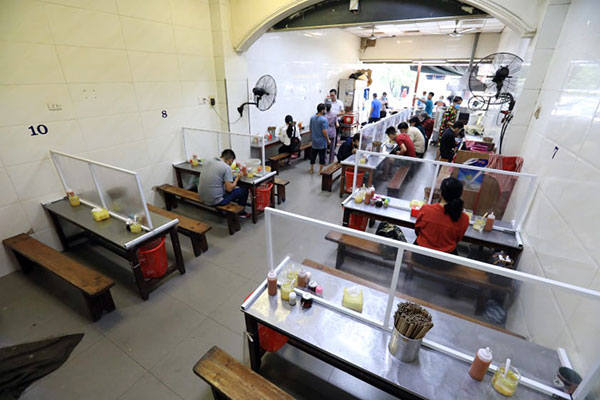Everyone needs to strictly follow the 5K guidelines and be cautious when interacting with strangers while dining at restaurants; establishments should also implement measures for proper ventilation, use partitions, as recommended by experts.
Associate Professor Dr. Tran Dac Phu, advisor to the Vietnam Public Health Emergency Response Center, stated that on an individual level, everyone must prepare thoroughly to protect themselves and the community. The 5K rule: Mask – Disinfection – Distance – No large gatherings – Health declaration must be strictly adhered to. This principle should be applied at all times and in every situation, such as attending meetings, shopping at supermarkets, visiting markets, using public transport, or receiving deliveries from couriers…
In the context of living with COVID-19, Mr. Phu emphasized the importance of only leaving home when absolutely necessary, particularly “extremely limiting” visits to restaurants, dining out, gathering, or sitting in cafes. When visiting a restaurant, one should be cautious when interacting with strangers or individuals at high risk. Everyone should carry a small bottle of hand sanitizer, wear a mask along with a face shield, and limit contact with objects unless necessary.
Clothes worn outside should be changed and thoroughly washed with soap; food purchased should be removed from its packaging or disinfected on the outside before being stored in the refrigerator.
The transmission mechanism of nCoV is respiratory via droplets, thus the risk of transmission remains high with close contact in enclosed spaces, as the virus can be transferred from contaminated surfaces to the nose, mouth, or eyes. Therefore, when restaurants reopen for on-site dining, large gatherings pose significant risks of COVID-19 transmission. Especially in cold seasons, with closed shops, customers sitting in confined, humid spaces… the risk of infection increases.
For restaurants to reopen safely, the first requirement is that the premises must be well-ventilated. “Ventilation measures are very important to prevent the spread of nCoV,” Mr. Phu said. Regularly clean the premises and keep doors and windows open for ventilation. Maintain open doors and windows and consider using fans to improve airflow. Maximize the intake of outdoor air.

Restaurants and eateries use partitions to prevent the spread of COVID-19. (Photo: internet).
The issue of ventilation has also been emphasized multiple times by Dr. Nguyen Hong Ha (Vice President of the Infectious Diseases Association). He believes that proper ventilation is the most effective measure. Numerous studies confirm that nCoV spreads rapidly in the air, especially in enclosed environments. In poorly ventilated areas such as closed rooms, airplane cabins, cars, hospital rooms, auditoriums, bars, and karaoke venues… droplets can linger in the air without escape. They can accumulate quickly, similar to cigarette smoke, reaching increasingly high concentrations, resulting in a significantly increased risk of infection for individuals in those environments.
“Therefore, proper ventilation is a long-term solution to eliminate nCoV. Restaurants looking to reduce the risk of infection when reopening for on-site dining must maximize ventilation,” Mr. Ha said.
In addition to ventilation, according to Mr. Phu, restaurants need to regularly disinfect surfaces such as door handles, stair railings, elevator buttons, phones, tables, chairs, and utensils… All shared equipment and serving items must be cleaned and disinfected or replaced frequently. All napkins or tablecloths that can be reused after customer service must be washed clean.
Regularly clean frequently touched surfaces in restrooms, such as toilet seats, door handles, counter tops, sinks, paper towel dispensers, soap dispensers… Implement procedures to enhance cleaning and disinfection in kitchen areas. Avoid contact with food surfaces when using disinfectants.
At restaurants, at each entrance, customers are required to scan a QR code for easy contact tracing. Each table should have partitions. Particularly, partitions should be placed in areas such as cash registers, bars, reception desks, and other areas where maintaining a minimum physical distance of 2 meters is difficult. Tables should also be arranged two meters apart, with encouragement to sit outdoors.
Consider splitting groups of 8 or fewer into multiple tables to ensure no large gatherings occur. If possible, seat individuals from the same group together to minimize contact with strangers. In establishments with play areas, consider limiting or temporarily suspending interactive activities involving large groups, such as children’s play areas, dance floors, and karaoke…
For self-service restaurants, such as buffets, handwashing stations should be provided for customers. Staff must wear masks or face shields, and customers should be encouraged to do the same.


















































